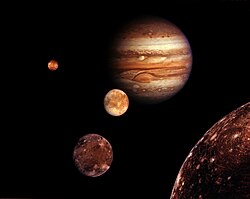 Loge (circled) imaged by the Cassini spacecraft in February 2015 | |
| Discovery | |
|---|---|
| Discovered by | Scott S. Sheppard David C. Jewitt Jan T. Kleyna Brian G. Marsden |
| Discovery date | 2006 |
| Designations | |
Designation | Saturn XLVI |
| Pronunciation | /ˈlɔɪ.eɪ/ or spelling pronunciation /ˈloʊɡiː/ |
Named after | Logi |
| S/2006 S 5 | |
| Orbital characteristics [1] | |
| 23065000 km | |
| Eccentricity | 0.187 |
| −1312.0 days | |
| Inclination | 167.9° |
| Satellite of | Saturn |
| Group | Norse group |
| Physical characteristics [2] [3] | |
| 5+50% −30% km | |
| 6.9±0.1? h | |
| Albedo | 0.06 (assumed) |
Spectral type | r – i = 0.15 ± 0.08 [4] |
| 24.6 | |
| 15.3 | |
Loge or Saturn XLVI is a natural satellite of Saturn. Its discovery was announced by Scott S. Sheppard, David C. Jewitt, Jan Kleyna, and Brian G. Marsden on 26 June 2006, from observations taken between January and April 2006.

